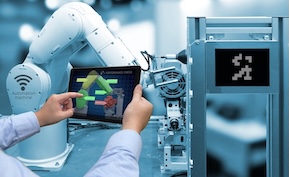Composable Manufacturing Platforms: Building Modular ERP and MES with Microservices
Manufacturing software is undergoing a major architectural transformation. Traditional monolithic ERP and MES systems, once the backbone of industrial operations, are giving way to modular, composable platforms built on microservices. This new approach allows manufacturers to customize, scale, and innovate faster by assembling software components like building blocks. Composable manufacturing platforms represent a shift from one-size-fits-all systems to flexible, adaptive ecosystems designed for the realities of modern production.
The shift from monolithic to modular
Legacy ERP and MES systems were designed as all-in-one solutions—comprehensive but often rigid. Modifying or upgrading a single feature typically required costly customizations or full system overhauls. As market conditions and technologies evolve faster, this model can no longer keep up. Composable architectures, powered by microservices and APIs, break down large applications into smaller, independent modules that can be deployed, updated, or replaced without disrupting the entire system.
What makes a platform composable
A composable platform is built around three key principles: modularity, interoperability, and orchestration. Each function—such as scheduling, quality management, or maintenance—is delivered as a microservice that communicates through standardized APIs. These services can run independently yet work together seamlessly. Orchestration layers manage workflows across modules, allowing manufacturers to create customized solutions that match their unique operational needs.
Advantages of microservices in manufacturing software
Microservices architecture brings agility and scalability to manufacturing systems. Because services operate independently, teams can develop and deploy updates without waiting for system-wide releases. This accelerates innovation and shortens the time to implement new capabilities. The architecture also enhances system resilience—if one module fails, others continue running normally. For manufacturers operating multiple plants or product lines, this modularity allows localized customization without compromising standardization.
Integration through APIs and data fabric
Composable platforms rely on robust API frameworks and data integration layers to unify operations. APIs enable smooth data exchange between ERP, MES, supply chain, and analytics systems. Data fabrics provide a centralized structure for harmonizing data across multiple sources, ensuring consistency and visibility. This architecture allows manufacturers to connect best-of-breed applications—such as AI analytics, IoT monitoring, and quality control tools—into one cohesive ecosystem.
Enabling flexibility in ERP and MES deployment
Composable ERP and MES platforms let manufacturers choose the features they need and scale gradually. For example, a company might start by deploying production planning and quality modules, then add maintenance or traceability capabilities as requirements evolve. Cloud-based deployment further enhances flexibility, allowing microservices to be hosted, scaled, and maintained independently. This modularity aligns perfectly with lean manufacturing principles, enabling continuous improvement without major software overhauls.
Faster innovation through open ecosystems
Open APIs and modular architectures encourage collaboration between software vendors, integrators, and customers. Manufacturers can extend core systems with niche solutions or in-house developments. This openness supports faster innovation, as new technologies—such as AI-driven optimization, digital twins, or sustainability tracking—can be added as plug-ins rather than full upgrades. The result is a software ecosystem that evolves at the speed of business, not the pace of traditional release cycles.
Security and governance in composable systems
While modular systems offer flexibility, they also require strong governance to maintain security and data integrity. Each microservice must adhere to standardized authentication, encryption, and access control policies. Centralized monitoring tools help track system performance, manage configurations, and ensure compliance with cybersecurity standards. Establishing governance frameworks ensures that composability enhances agility without increasing operational risk.
Reducing total cost of ownership
Composable architectures help reduce total cost of ownership by minimizing large-scale upgrades and reducing downtime during deployment. Manufacturers pay only for the services they use and can replace underperforming modules without costly reimplementation. Cloud-native microservices also lower infrastructure costs by enabling elastic scalability and automated updates. Over time, these efficiencies translate into faster ROI and a more sustainable technology roadmap.
The path toward composable manufacturing
Transitioning to composable manufacturing platforms requires a phased approach. Manufacturers should begin by assessing their current systems, identifying bottlenecks, and prioritizing modular replacements that deliver immediate value. Building a foundation of open APIs and unified data governance prepares the organization for future expansion. Partnering with vendors that support interoperability and modularity ensures long-term flexibility as technology and market demands evolve.
The takeaway
Composable manufacturing platforms represent the future of industrial software. By embracing microservices, open APIs, and modular design, manufacturers gain the agility to innovate quickly, adapt to change, and scale efficiently. This architecture transforms ERP and MES systems from static tools into living ecosystems—capable of evolving alongside the business, supporting continuous improvement, and powering the next generation of intelligent manufacturing.







